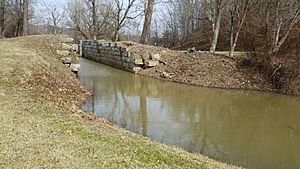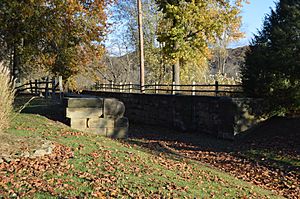Hocking Canal facts for kids

The Hocking Canal was a small waterway built in the 1800s in southern Ohio. It connected the city of Athens to Lancaster and then to a bigger canal called the Ohio and Erie Canal. Sadly, floods later destroyed the Hocking Canal, and it was never rebuilt. It followed along the Hocking River.
Contents
Building the Hocking Canal
In 1829, some business owners in southern Ohio wanted to move products like salt to markets faster. They decided to build a branch canal. This new canal would start from the Ohio and Erie Canal at Carroll, Ohio and go south towards Lancaster.
Work on this part of the canal, sometimes called the "Lancaster lateral," began in 1831. It was finished on September 4, 1838. That same year, the state of Ohio bought this section of the canal. Ohio then decided to make the canal even longer. They extended it from Lancaster all the way to Logan, Nelsonville, Chauncey, and Athens. This added about 53 miles to the canal. The entire 56-mile canal was completed in 1843, though many parts were open two years earlier.
What the Canal Carried
The Hocking Canal helped transport many goods. Things like salt, coal, pork products, wool, and lumber were shipped out of Athens and Hocking counties. In return, furniture and iron products were brought into these areas.
The canal had 26 locks, which are like water elevators that help boats move up and down hills. It also had 7 culverts (tunnels for water) and an aqueduct (a bridge that carries water) that crossed Monday Creek near Nelsonville.
However, the canal never made much money. The 15-mile section between Nelsonville and Athens was especially unprofitable. Many salt factories were in this area. The factory owners found the canal boats too slow, moving at only about 4 miles per hour. Also, the canal often froze in winter, making it unusable. Because of these problems, the salt factory owners started building a railroad called the Columbus and Hocking Valley Railroad. By 1857, this railroad was competing with the canal for cargo.
The Canal During the Civil War
During the American Civil War, a famous event called Morgan's Raid happened. A group of Confederate cavalry (soldiers on horseback) led by John Hunt Morgan stopped in Nelsonville. They burned ten wooden canal boats.
However, they tried to burn a covered bridge over the Hocking Canal but failed. Citizens quickly rushed to put out the fire after the raiders left. This was important because it allowed Union cavalry to keep chasing the fleeing Confederates.
The End of the Canal
Repeated floods, especially in the late 1800s, badly damaged parts of the canal. At the same time, railroads became a much more popular way to transport goods. In 1890, the Hocking Canal was officially closed down.
Today, you can still see parts of the old canal in some places. A modern bikeway has been built on what used to be the towpath, which was the path where horses or mules walked to pull the canal boats. The old Lock #19 is now a park next to the road in eastern Starr Township, west of Nelsonville. Other parts like old dams, aqueducts, and other locks can also still be found. Sadly, the very last parts of the Hocking Canal in the city of Athens were removed in 1983 to build new homes.


